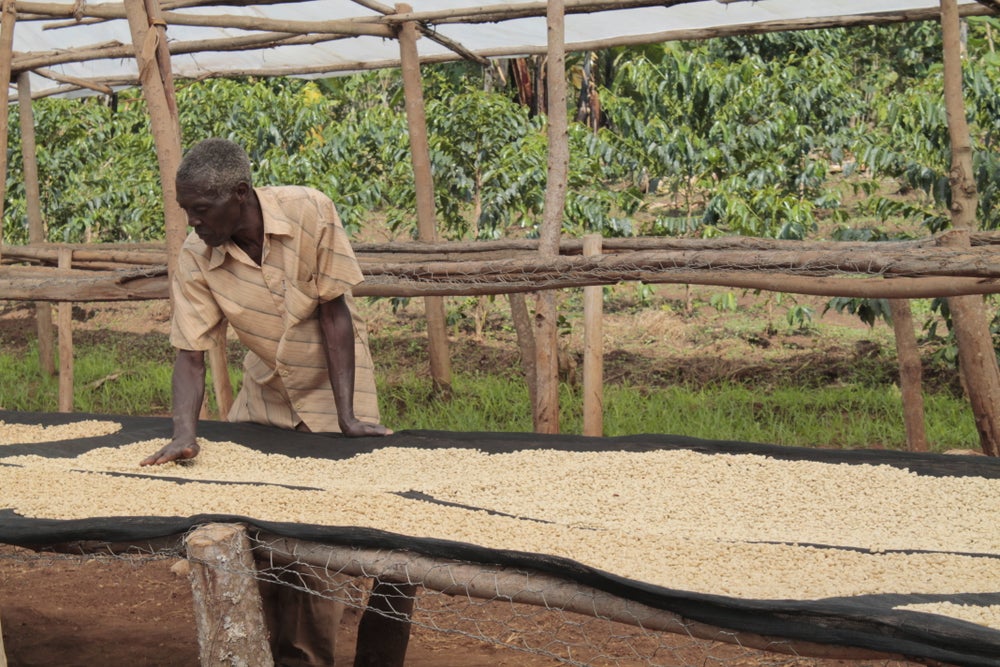

Democratic Republic of Congo
Coffee once played a huge part in the Democratic Republic of Congo’s (DRC) economy. Eastern DRC was called “a paradise for coffee.” Unfortunately, the country’s dark colonial history followed by waves of political turmoil limited prosperity in the coffee sector. Today, coffee’s making a comeback as a number of private and public sector actors invest in the country. We believe DRC is a country to watch as it continues to build the infrastructure and knowledge needed for specialty coffee production.
Details
- Place In World Production:
- #26
- Average Annual Production:
- 340,000 (in 60kg bags)
- Common Arabica Varieties:
- Bourbon
- Key Regions:
- Oriental Province | North Kivu | South Kivu
- Harvest Months:
- April - July
Offers
Coffee Comes to Congo
The Democratic Republic of Congo (DRC) was once known as the breadbasket of Africa. The country has 75 to 80 million hectares of arable land that stretch from the high hills of Province Orientale to the Northeast, through the rainforests of Virunga National Park and down to the volcanic soil on the shores of Lake Kivu.
The first European in the DRC was the famed explorer, David Livingstone who set off in 1869 to find the source of the Nile. After no word for over three years, most presumed him dead, until the tenacious and deeply narcissistic Henry Morgan Stanley ‘found’ him on the shores of Lake Tanganyika (modern day Tanzania). Stanley engraved his name on history’s pages when he greeting the missing explorer with “Livingstone, I presume?”
The exact date of coffee’s arrival in DRC is unknown, but it undoubtably came with early European settlers to the region. At a time when Europe’s main coffee producer, Indonesia, was embroiled in a battle with the then-new Coffee Leaf Rust (CLR), the DRC, like many colonized nations, was geared to fill the European taste for coffee.
Livingstone’s ‘discovery’ of DRC drew the attention of King Leopold II of Belgium, who happened to be looking for a colony to call his own. In addition to DRC’s vast reserves of gold, copper, rubber and cobalt, coffee (which could exploit the fertile lands above ground) became a preferred wealth-generating tool for the king.
Leopold II’s reign ran officially from 1885 to 1908—but his influence and style of governance continued until independence in 1960. Unfortunately, independence in 1960 brought political disruption that lasted for many years and had negative consequences for coffee production until very recently.
Coffee Post-Independence
The post-independence era brought in political turmoil that lasted roughly from 1960 until the 1990s. Many of the country’s smallholder farmers suffered as a result. As a major cash crop, coffee, whose production had been expanding rapidly since the 1960s and was second only to copper exports, was seen as a means to advancing the economic prosperity of some of the most impoverished Congolese people.
It’s difficult to exaggerate the importance coffee held for DRC’s economy—and to individual survival—at the time. Although copper and other mineral exports were the major wealth drivers in the country, the profits from those sectors went almost entirely to the mine owners. Coffee, while far from a perfect system, did return at least a portion of the revenue to smallholder families. Copper and cobalt may have made the giant political engines of the DRC run, but coffee kept many people alive.
In 1997, facing new opportunities for economic advancement for the first time since 1960, DRC and the world were hopeful that coffee would be a means to grow DRC’s economy and improve livelihoods. And the coffee industry itself looked ready to take off. However, political turmoil began again, and coffee took a huge hit. According to the New York Times, the amount of coffee produced in 2010 was less than a tenth of production in 1990. Many farmers, facing starvation and penury, risked their lives crossing lake Kivu by boat to sell their coffee on the Rwandan side of the lake. The journey was treacherous. According to several sources, as many as 1,000 people died each year, mainly from drowning. Even if farmers crossed the water safely, they risked being robbed or attacked on both sides of lake. No one, even those who completed the journey relatively unharmed, was able to get full value for their coffee.
In addition to causing up to six million deaths by conflict, disease or malnutrition (according to the BBC), millions were displaced during the civil wars that ravaged the DRC for almost 2 decades. Some of the areas most badly affected by the wars were in the east, one of the prime coffee growing regions. As a result, many farms were destroyed or were untended for years because it was unsafe to return. Those who have been able to return home find themselves having to invest more to reinvigorate their farmland. Others who still lack their own land are left with a constant uncertainty that makes it difficult to plant trees like coffee that can take several years and substantial work to bear fruit.
Coffee Today
Today, peacetime has brought calm to the region and things have been more stable. However, coffee farmers are often subject to fake taxes, demands for bribes and other barriers to business caused by corruption and exploitation.
After more than 30 years of conflict, it is understandable that the agricultural sector in Eastern DRC is still recovering. Going forward, the coffee sector will play an instrumental role in rebuilding the economic and social fabric of the country. Investment by private and public sector actors has helped establish cooperatives and washing stations that aim not only to improve coffee quality and pricing but also to alleviate social problems, such as gender inequality. Things are looking up in the DRC.